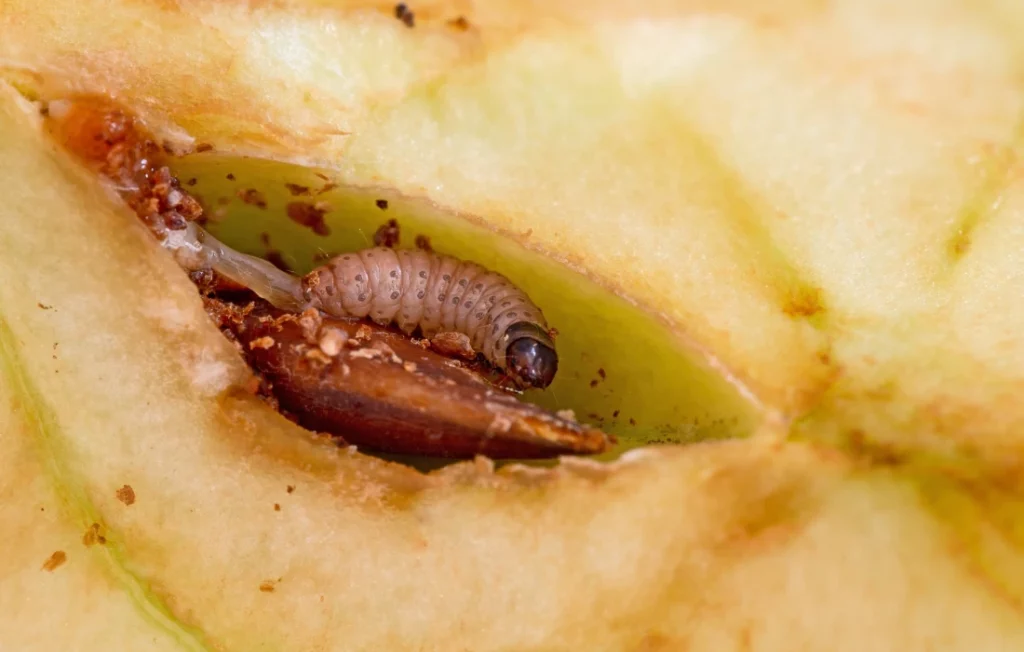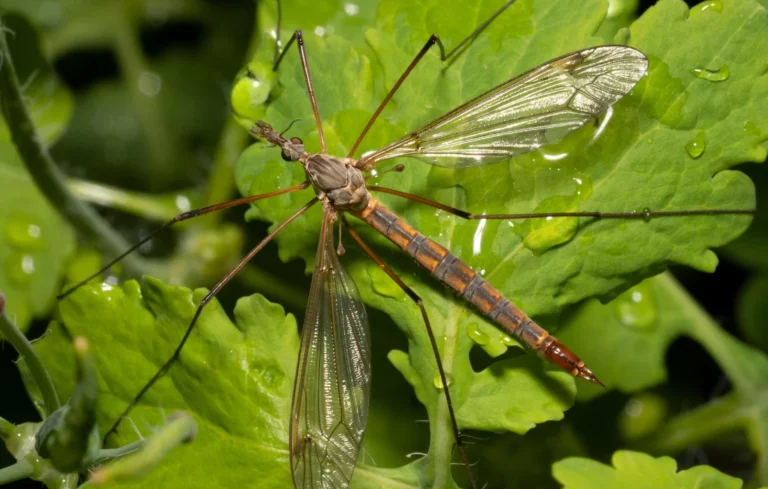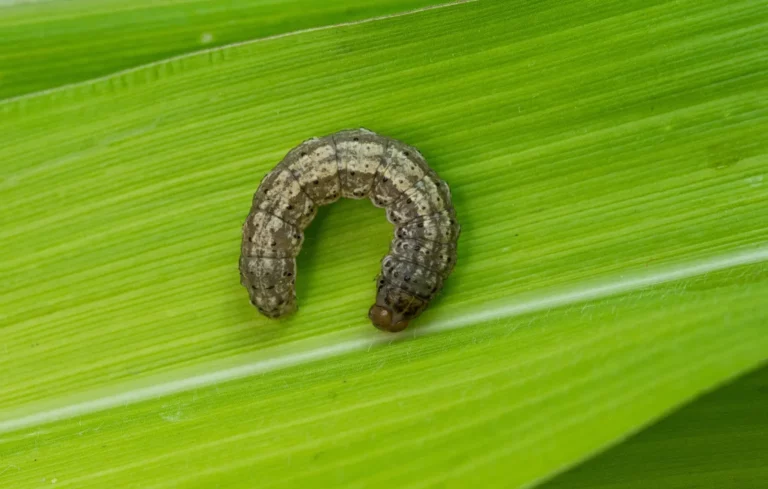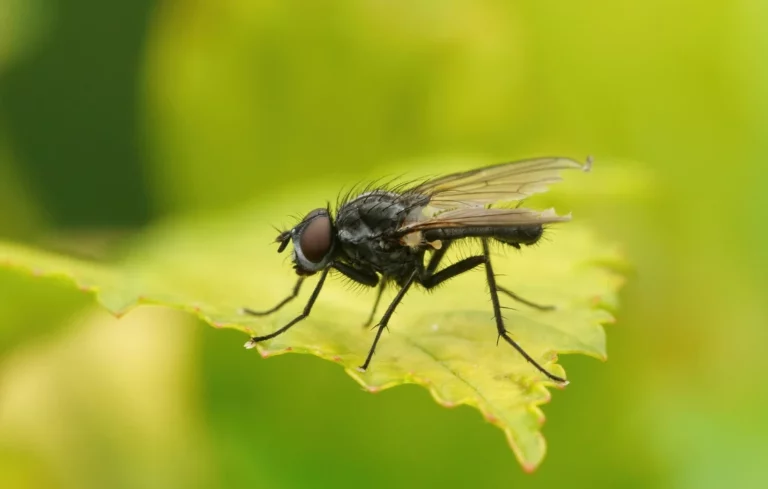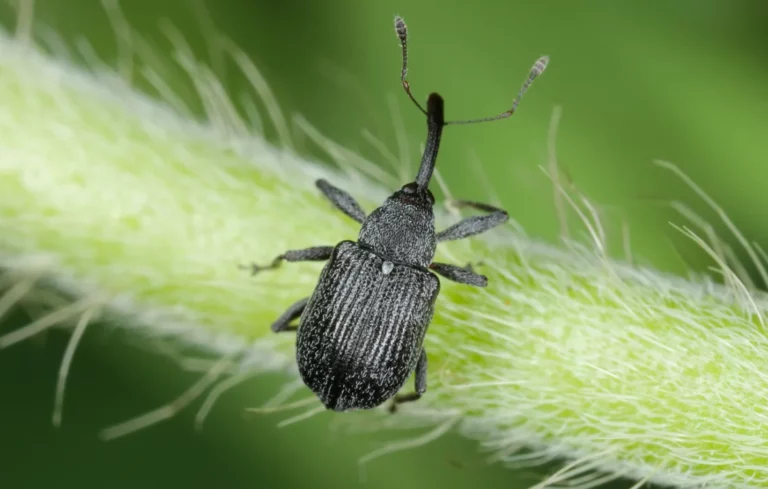In apple and pear orchards, a small butterfly can wreak havoc. It’s the Cydia pomonella , better known as the codling moth. Behind its discreet appearance hides a formidable pest, whose larvae bore into the fruit to reach the heart, leaving behind galleries soiled with droppings. Every year, this threat jeopardizes the harvest of fruit growers, whether they practice organic or conventional agriculture. Understanding its biology and adopting appropriate natural solutions allows us to anticipate its attacks and limit its impacts.
Morphology of Cydia pomonella
The adult codling moth is a small moth with a wingspan of 15 to 22 mm . Its forewings are brownish-grey and have a dark brown spot highlighted with golden highlights, while its hindwings are more uniform and edged with fine eyelashes. Its head has two long, threadlike antennae, characteristic of Lepidoptera.
The larva , on the other hand, is much more feared. It begins its development as a whitish tint before turning pale pink. Its head, a pronounced brown, contrasts with its cylindrical body, which reaches up to 15 mm long at maturity. It is this larva that hollows out the fruit, causing the main damage observed.
Before becoming an adult, the larva transforms into a chrysalis , wrapped in a whitish cocoon. This pupation takes place in the folds of the bark or in the ground, out of sight and out of reach of others.
Which plants are attacked by the codling moth?
The codling moth primarily attacks the following fruit trees:
- Apple
- Pear tree
- Quince tree
- Apricot
- Fishing (less common case)
- Plum tree (less common case)
- Walnut
Do you need a natural solution against codling moth on apples and pears?
Life cycle
Cydia pomonella can develop two to three generations each year, depending on climatic conditions. Its life cycle begins with the overwintering of the mature larva, well protected in a cocoon hidden in the soil or bark.
In spring, between April and June , the first generation of adults emerge. Their flights only begin at dusk and only if the temperature exceeds 15°C for several days in a row. After mating, the female lays between 50 and 80 eggs on leaves, stems or directly on the fruit.
The newly hatched young larva then enters an active phase. It explores its environment in search of a fruit to colonize. Once established, it pierces the skin and digs a spiral tunnel until it reaches the seeds, which it consumes. Its passage leaves visible droppings at the entrance to the tunnel.
Before transforming, it can exit the fruit through another orifice , leaving behind a characteristic hole surrounded by sawdust.
Once its development is complete, it then withdraws into the ground or the crevices of the tree to begin its metamorphosis into a chrysalis, which will measure between 9 and 10 mm.
What damage is observed from the codling moth of apple and pear trees?
Codling moth attacks are characterized by the presence of wormy fruits , often falling before maturity. To the naked eye, one can see entry or exit holes , accompanied by droppings in the form of brownish sawdust. These signs indicate the presence of larvae that have dug their way into the seeds, making them unfit for consumption.
In addition to the visible damage, codling moths can introduce pathogenic fungi into the fruit, such as those of the genus Penicillium . These molds produce a toxin, patulin, which is strictly regulated in apple juices and preparations. In the event of a heavy infestation, the entire harvest can be compromised, both in quantity and quality.
Biological control solutions for codling moth in apple and pear trees
When dealing with codling moths, a rational and natural approach can limit damage while maintaining the balance of the orchard. The goal is not only to reduce populations, but also to disrupt their cycle to prevent reproduction.
Pheromone trapping is a first strategy. By setting traps in the spring, males or both males and females are attracted by adapting the specific pheromones, allowing for precise monitoring of flight periods. This data is valuable for adjusting interventions at key moments. Traps don’t just capture; they play an essential monitoring role.
Yellow glue traps , which mimic the color of fruit, can also be used to trap certain adults looking to lay eggs. They are part of an integrated pest management approach, combined with other cultural practices.
Orchard maintenance also plays a role. Removing fallen fruit, hoeing the soil, or brushing the trunks to reduce winter shelters can reduce the larvae’s chances of survival.
At Agrobiotop, we develop targeted natural solutions, adapted to each stage of codling moth development , by combining observation, biocontrol and soil care. Each action is part of a logic of prevention and regeneration, for more resilient and sustainable agriculture.
Agrobiotop Solutions
- YAKASELF Biostimulant (Application dose 25 liters /300 liters of water/hectare)
- Yellow glued plate 2 sides 25 X 10
- Yellow glued plate 2 sides 25 X 40
- Yellow FUNNEL type trap
- DELTAP type PVC trap + glued refill plate
- Male pheromones ( Cydia pomonella )
- Male and female pheromones ( Cydia pomonella )
Do not hesitate to contact us for more information.
Other problems with fruit trees:
Photo : Shutterstock

